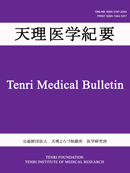Volume 22, Issue 2
Tenri Medical Bulletin
Displaying 1-9 of 9 articles from this issue
- |<
- <
- 1
- >
- >|
Case Report
-
Article type: case-report
2019Volume 22Issue 2 Pages 54-62
Published: December 25, 2019
Released on J-STAGE: December 25, 2019
Download PDF (7115K)
2018 Symposium of the Tenri Institute of Medical Research
-
Article type: 2018 Symposium of the Tenri Institute of Medical Research
2019Volume 22Issue 2 Pages 64-70
Published: December 25, 2019
Released on J-STAGE: December 25, 2019
Download PDF (3871K) -
Article type: 2018 Symposium of the Tenri Institute of Medical Research
2019Volume 22Issue 2 Pages 71-78
Published: December 25, 2019
Released on J-STAGE: December 25, 2019
Download PDF (1922K) -
Article type: 2018 Symposium of the Tenri Institute of Medical Research
2019Volume 22Issue 2 Pages 79-85
Published: December 25, 2019
Released on J-STAGE: December 25, 2019
Download PDF (2744K) -
Article type: 2018 Symposium of the Tenri Institute of Medical Research
2019Volume 22Issue 2 Pages 86-92
Published: December 25, 2019
Released on J-STAGE: December 25, 2019
Download PDF (2082K) -
Article type: 2018 Symposium of the Tenri Institute of Medical Research
2019Volume 22Issue 2 Pages 93
Published: December 25, 2019
Released on J-STAGE: December 25, 2019
Download PDF (165K) -
Article type: 2018 Symposium of the Tenri Institute of Medical Research
2019Volume 22Issue 2 Pages 94-100
Published: December 25, 2019
Released on J-STAGE: December 25, 2019
Download PDF (741K)
Pictures at Bedside and Bench
-
Article type: Pictures at Bedside and Bench
2019Volume 22Issue 2 Pages 101-105
Published: December 25, 2019
Released on J-STAGE: December 25, 2019
Download PDF (4548K)
Meeting Report
-
Article type: meeting-report
2019Volume 22Issue 2 Pages 106-108
Published: December 25, 2019
Released on J-STAGE: December 25, 2019
Download PDF (4963K)
- |<
- <
- 1
- >
- >|
